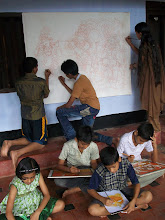Bharata Nâtya Sâstra 5th century B.C. – 3rd century A. D.
Discussion on all art forms present in theatre and on the purpose and essence of art
Commentators on Bharata
Lollata A. D. 9th century
Sankuka 9th century
Bhattanayaka 9th – 10th century
Abhinavagupta Abhinvabhratai Locana 10th – 11th CAD Commentaries on Nâtya Sâstra and Dhvanyâloka. Most influential commentary on almost all art forms with special focus on rasa and dhvani
Texts on The Alamkâras Theory
Bhâmaha Kâvyalankâra 7th – 8th century
First comprehensive work on poetics, on alamkâras ,
also the concept of vakrokti
Dândin Kâvyâdarsa 8th century Highlights guna-riti. Alamkâras theory articulated more cogently; shows some influence of
Nâtya Shâstra.
Udbhata Kâvyâlankârasarasangrahah 8th – 9th centuryAlong with focus on alamkâras s, he also discusses rasa and doesn’t seem convinced about dhvani
Rudrata Kâyvâlankâra 9th century Again focus on alamkâras as well as brief discussion of rasa
The Riti Theory |
Vâmana 8th – 9th century
The first to ask questions about the soul of poetry – and focuses on riti or style
The Dhvani Theory
Anandavardhana Dhvanyâloka:9th
CAD:Focuses on the role of suggestion – dhvani – in poetic language. Also links rasa to dhvani.
Abhinavagputa Locana:11thCAD:Comments on Dhvanyâloka. Establishes rasa-dhvani as a very powerful concept.
Miscellaneous Writers on Poetics
Râjasekhara Kâvyamimamsâ 10th CAD Different aspects of poetics discussed
Dhanamjaya 10th CAD Different aspects of poetics discussed
Kuntaka Vakroktijivita 10th – 11th CAD Elaborates the theory of vakrokti or poetic language of indirection
Kshemendra Aucityavichâracharcâ 11th CAD Elaborates the concept of appropriateness or aucitya
Sringâra Prakâsa Samarangana-sutradhara 11th CAD Rasa theory, different types of plays, performanceMusic, art and architecture
Mahimâbhatta 11th CAD Important commentator on earlier theories
Hemacandra Kâvyanusâsanam 1088-1172 Handbook of poetics discussing earlier theories
RuyyakaAlankârasarvasva 12th CAD Important commentator on earlier theories
Visvanâtha Sâhityapardna 14th CAD Handbook of poetics discussing earlier theories. In addition, it deals with performance as well
Appayyâ Diksita Kuvalyanandah 16th – 17th CAD Important commentator on earlier theories
Jagannâtha Rasagangâdharah 17th CAD This too deals with the entire field of poetics
Other Major Works/Critics on Aesthetics
Bruhatsâmhita Varâhamihira Chapters on iconography and silpaNâtya Sâstra - Significant contribution to dance
Vâstusutra Upanisad Part of Paiplada samhita, a very important treatise that deals with the philosophy of architecture and discusses rasa in this context
Abhinaya Darpana Nandikeswara3rd century (?) ADMost significant treatise on dance after Nâtya Sâstra
Vishnudharmottara Purâna 7th cent. A purâna with chapters on architecture, painting, music, dance, poets, etc. attributed to the late Gupta period.
Nâradasilpa - On architecture and art
Prajâpati Silpa - On architecture and art
Abhinavabhârati SamaranganasutradharaBhoja11th century Discussion on music, painting, sculpture and architecture
Sangitaratnâkara Sârangadeva Simha Bhopala and Kâlinath13th century14th & 15th centuryEncyclopedic treatise on music Commentators
Râgatarangini Locanakavi Râmamatya15th century Treatise on musicCommentator
Silpasâstra Mandana15th century
Saraswati Silpa - On architecture and art
Silparatna 16th centuryOn architecture and art: Very popular in Kerala
